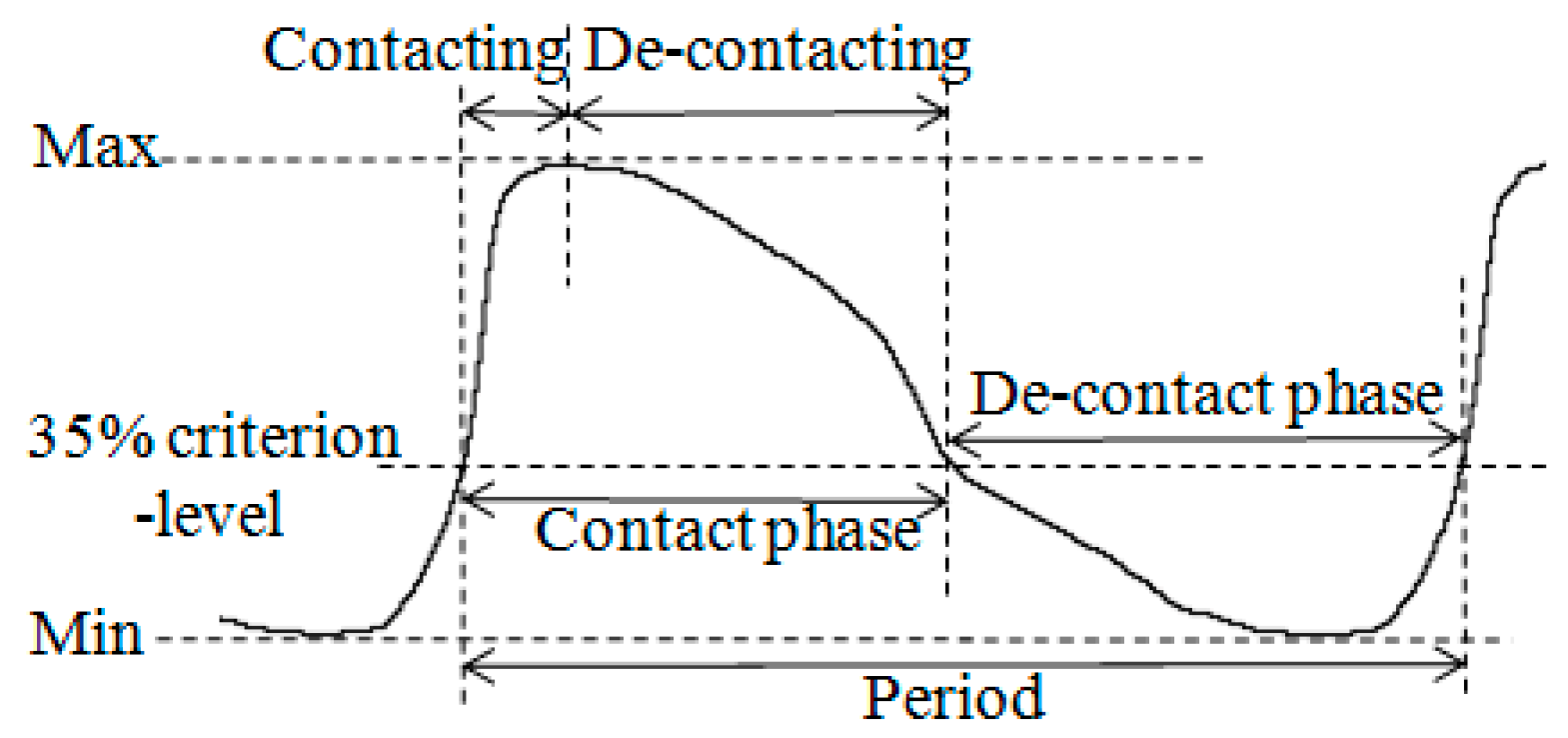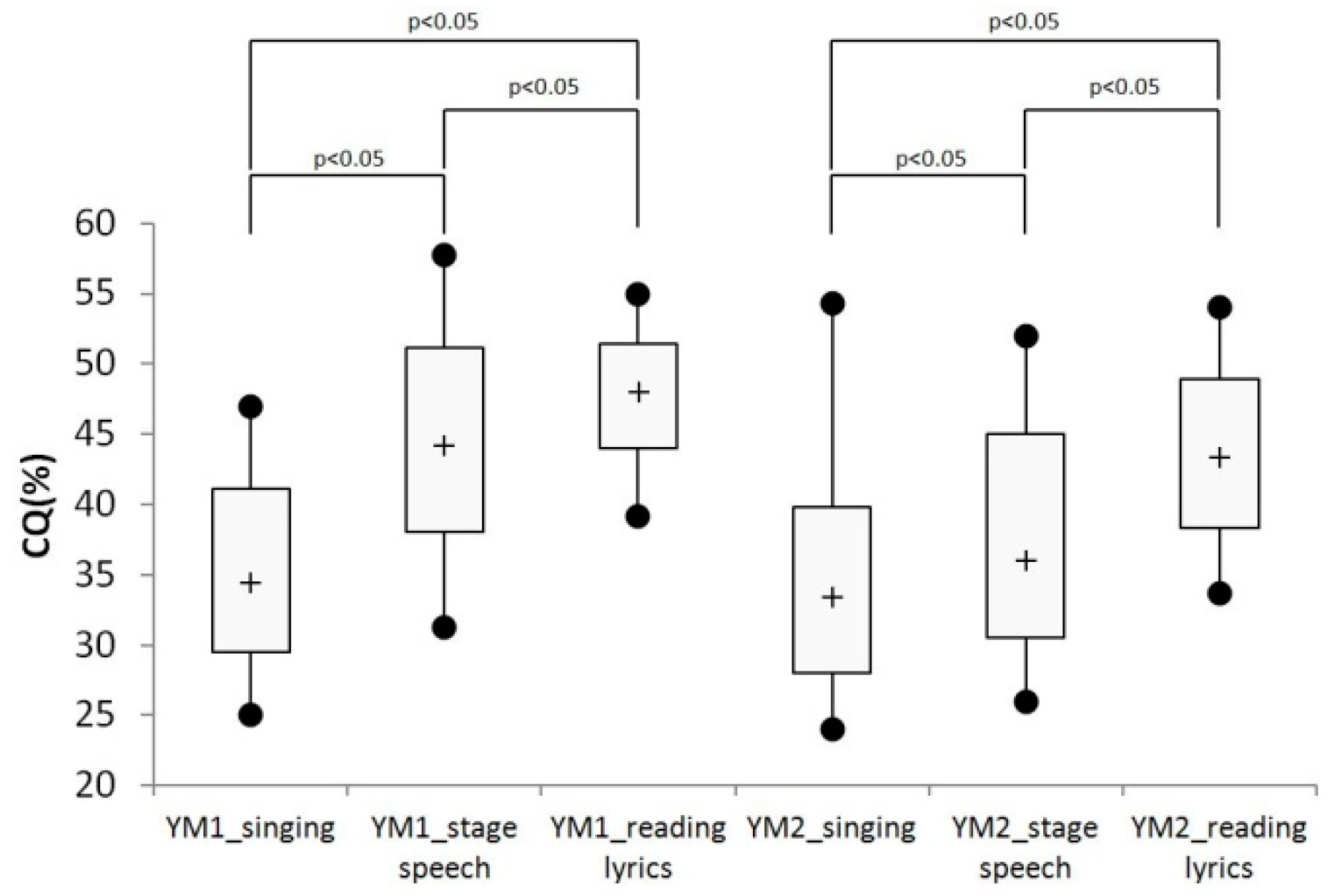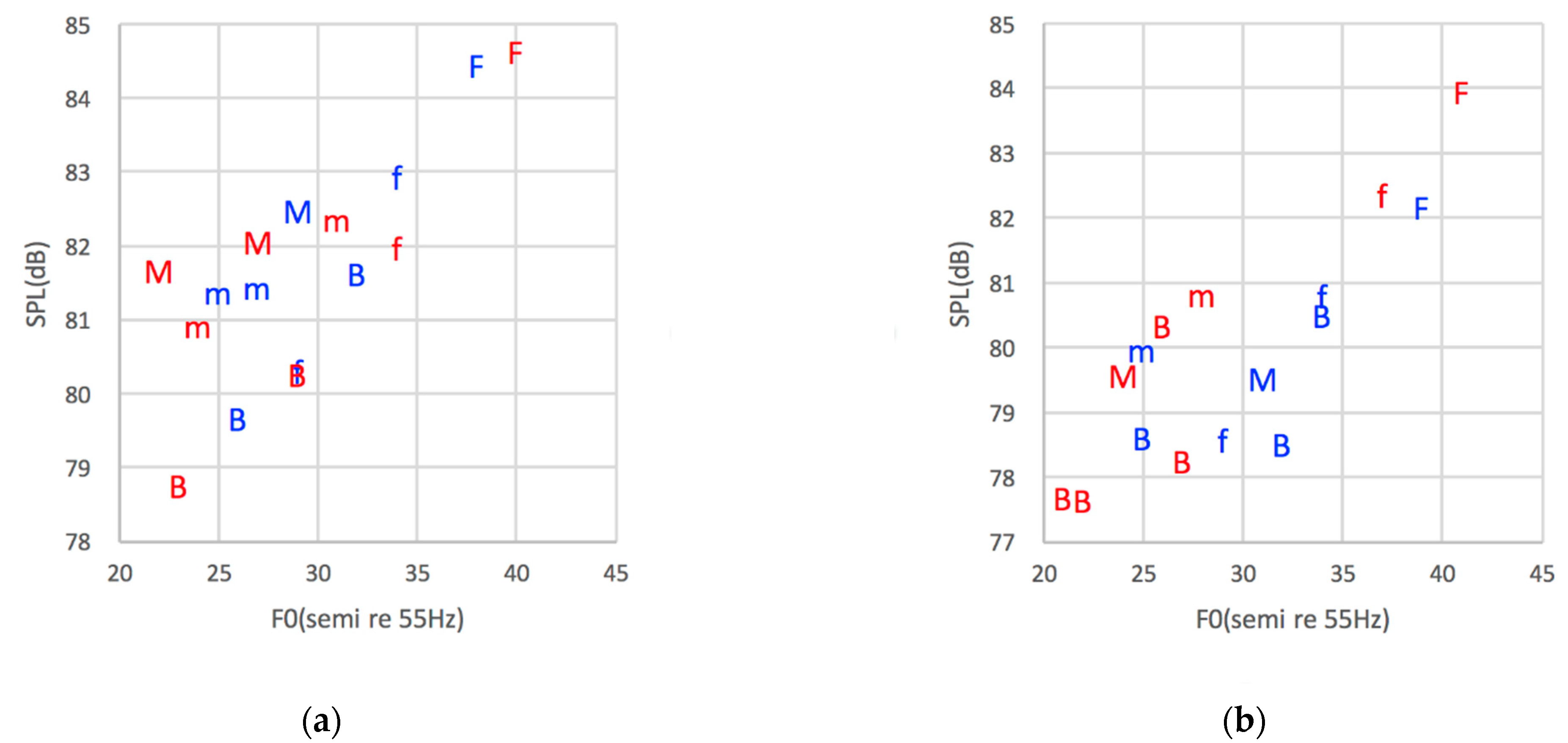Electroglottographic Analysis of the Voice in Young Male Role of Kunqu Opera
Abstract
1. Introduction
1.1. Young Male Role in Kunqu Opera
1.2. EGG Analysis
2. Materials and Methods
3. Results
3.1. Distributions of EGG Parameters
3.2. Phonation Types
3.3. Clustering Analysis
3.4. SPL Analysis
4. Discussion
5. Conclusions
Author Contributions
Funding
Institutional Review Board Statement
Informed Consent Statement
Data Availability Statement
Acknowledgments
Conflicts of Interest
References
- Wu, X. Dictionary of Chinese Kunqu Opera; Nanjing University Press: Nanjing, China, 2002; pp. 565–568. [Google Scholar]
- Dong, L.; Kong, J.; Sundberg, J. Long-term-average spectrum characteristics of Kunqu opera singers’ speaking, singing and stage speech. Logoped. Phoniatr. Vocol. 2014, 39, 72–80. [Google Scholar] [CrossRef]
- Tian, S. Research on Kunqu Opera Singing Art; Zhejiang University Press: Hangzhou, China, 2013; pp. 6–18. [Google Scholar]
- Laver, J. The Phonetic Description of Voice Quality; Cambridge University Press: London, UK, 1980. [Google Scholar]
- Kong, J. On Language Phonation; Central Nationalities University Press: Beijing, China, 2001; pp. 159–189. [Google Scholar]
- Fant, G. Speech Acoustics and Phonetics; Springer Netherlands: Berlin, Germany, 2005. [Google Scholar]
- Sundberg, J. The Science of the Singing Voice; Northern Illinois University: DeKalb, IL, USA, 1987. [Google Scholar]
- Welch, G.F.; Sergeant, D.C.; Maccurtain, F. Xeroradiographic-electrolaryngographic analysis of male vocal registers. J. Voice 1989, 3, 244–256. [Google Scholar] [CrossRef]
- Rothenberg, M. Some relations between glottal air flow and vocal fold contact area. In Proceedings of the Conference on the Assessment of Vocal Pathology; American Speech and Hearing Association, Ed.; American Speech and Hearing Association: Rockville, MD, USA, 1981; pp. 88–96. [Google Scholar]
- Baer, T.; Löfqvist, A.; McGarr, N.S. Laryngeal vibrations: A comparison between high-speed filming and glottographic techniques. J. Acoust. Soc. Am. 1983, 74, 1304–1308. [Google Scholar] [CrossRef] [PubMed]
- Childers, D.G.; Naik, J.M.; Larar, J.N.; Krishnamurthy, A.K.; Moore, G.P. Electroglottography, speech, and ultra-high speed cinematography. In Vocal Fold Physiology and Biophysics of Voice; Titze, I.R., Scherer, R., Eds.; Denver Center of Performing Arts: Denver, CO, USA, 1983; pp. 202–220. [Google Scholar]
- Herbst, C.T.; Schutte, H.K.; Bowling, D.L.; Svec, J.G. Comparing Chalk With Cheese—The EGG Contact Quotient Is Only a Limited Surrogate of the Closed Quotient. J. Voice 2017, 31, 401–409. [Google Scholar] [CrossRef]
- Baken, R.J.; Orlikoff, R.F. Clinical Measurement of Speaking and Voice; Delmar Learning: New York, NY, USA, 2000. [Google Scholar]
- Yoshinaga, I.; Kong, J. Laryngeal vibratory behavior in traditional Noh singing. Tsinghua Sci. Technol. 2012, 17, 94–103. [Google Scholar] [CrossRef]
- Esling, J.H. A laryngographic investigation of phonation type and laryngeal configurations. Work. Pap. Linguist. Circle Univ. Vic. 1983, 14–36. [Google Scholar]
- Dong, L.; Kong, J. Voice characteristics of young Girl Role in Kunqu Opera. J. Voice 2019, 33, e945.e19–e945.e25. [Google Scholar] [CrossRef] [PubMed]
- Herbst, C.; Ternström, S. A comparison of different methods to measure the EGG contact quotient. Logoped. Phoniatr. Vocol. 2006, 31, 126–138. [Google Scholar] [CrossRef]
- Timcke, R.; Von, L.H.; Moore, P. Laryngeal vibrations: Measurements of the glottic wave: Part II--Physiologic variations. Ama. Arch. Otolaryngol. 1959, 68, 438–444. [Google Scholar] [CrossRef]
- Fant, G. Studies of the human voice source. Acta Acust. 1988, 13, 135–146. [Google Scholar]
- Titze, I.R. Interpretation of the electroglottographic signal. J. Voice 1990, 4, 1–9. [Google Scholar] [CrossRef]
- Childers, D.G.; Hicks, D.M.; Moore, G.P.; Alsaka, Y.A. A model for vocal fold vibratory motion, contact area, and the electroglottogram. J. Acoust. Soc. Am. 1986, 80, 1309–1320. [Google Scholar] [CrossRef]
- Henrich, N.; D’Alessandro, C.; Doval, B.; Castellengo, M. On the use of the derivative of electroglottographic signals for characterization of nonpathological phonation. J. Acoust. Soc. Am. 2004, 115, 1321–1332. [Google Scholar] [CrossRef] [PubMed]
- Rothenberg, M.; Mahshie, J.J. Monitoring vocal fold abduction through vocal fold contact area. J. Speech Hear. Res. 1988, 31, 338–351. [Google Scholar] [CrossRef] [PubMed]
- Howard, D.M.; Lindsey, G.A.; Allen, B. Toward the quantification of vocal efficiency. J. Voice 1990, 4, 205–212. [Google Scholar] [CrossRef]
- Howard, D.M. Variation of electrolaryngographically derived closed quotient for trained and untrained adult female singers. J. Voice 1995, 9, 163–172. [Google Scholar] [CrossRef]
- Dong, L.; Sundberg, J.; Kong, J. Loudness and pitch of Kunqu Opera. J. Voice 2014, 28, 14–19. [Google Scholar] [CrossRef] [PubMed]
- Kong, J. VoiceLab 1.0; National Copyright Administration of the People’s Republic of China: Beijing, China, 2012. [Google Scholar]
- Dong, L.; Sundberg, J.; Kong, J. Formant and voice source properties in two male Kunqu Opera roles: A pilot study. Folia. Phoniatr. Logo. 2014, 65, 294–302. [Google Scholar] [CrossRef]
- Dong, L. Voice characteristics of young woman role in Kunqu Opera. Essays Linguist. 2016, 54, 292–304. [Google Scholar]
- Herbst, C.T.; Howard, D.; Schlömicher-Thier, J. Using electroglottographic real-time feedback to control posterior glottal adduction during phonation. J. Voice 2010, 24, 72–85. [Google Scholar] [CrossRef]
- Kong, J. Laryngeal Dynamics and Physiological Models; Peking University Press: Beijing, China, 2007. [Google Scholar]
- Ternström, S. Normalized time-domain parameters for electroglottographic waveforms. J. Acoust. Soc. Am. 2019, 146, EL65–EL70. [Google Scholar] [CrossRef] [PubMed]
- Mayr, A. Investigating the voce faringea: Physiological and acoustic characteristics of the bel canto tenor’s forgotten singing practice. J. Voice 2017, 31, 255.e13–255.e23. [Google Scholar] [CrossRef] [PubMed]








| Singer | Singing | Stage Speech | ||||||||||
| No. | fo/Semi | CQ/% | SQ/% | P/% | PT | No. | fo/Semi | CQ/% | SQ/% | P/% | PT | |
| YM1 | 1 | 25 | 43 | 318 | 10 | m | 1 | 22 | 57 | 414 | 7 | M |
| 2 | 26 | 33 | 216 | 15 | B | 2 | 23 | 28 | 184 | 9 | B | |
| 3 | 27 | 46 | 166 | 7 | m | 3 | 24 | 41 | 299 | 10 | m | |
| 4 | 29 | 50 | 269 | 6 | M | 4 | 27 | 53 | 297 | 15 | M | |
| 5 | 29 | 25 | 115 | 18 | f | 5 | 29 | 59 | 90 | 5 | B | |
| 6 | 32 | 36 | 139 | 11 | B | 6 | 31 | 47 | 210 | 13 | m | |
| 7 | 34 | 31 | 105 | 21 | f | 7 | 34 | 35 | 104 | 18 | f | |
| 8 | 38 | 39 | 126 | 11 | F | 8 | 40 | 44 | 118 | 22 | F | |
| YM2 | 1 | 25 | 39 | 258 | 11 | m | 1 | 21 | 37 | 289 | 9 | B |
| 2 | 25 | 35 | 173 | 19 | B | 2 | 22 | 25 | 146 | 10 | B | |
| 3 | 29 | 25 | 115 | 21 | f | 3 | 24 | 49 | 335 | 7 | M | |
| 4 | 31 | 58 | 289 | 3 | M | 4 | 26 | 36 | 200 | 15 | B | |
| 5 | 32 | 58 | 99 | 8 | B | 5 | 27 | 53 | 132 | 8 | B | |
| 6 | 34 | 36 | 148 | 10 | B | 6 | 28 | 47 | 240 | 16 | m | |
| 7 | 34 | 28 | 112 | 19 | f | 7 | 37 | 28 | 109 | 18 | f | |
| 8 | 39 | 38 | 124 | 9 | F | 8 | 41 | 35 | 111 | 17 | F | |
Publisher’s Note: MDPI stays neutral with regard to jurisdictional claims in published maps and institutional affiliations. |
© 2021 by the authors. Licensee MDPI, Basel, Switzerland. This article is an open access article distributed under the terms and conditions of the Creative Commons Attribution (CC BY) license (https://creativecommons.org/licenses/by/4.0/).
Share and Cite
Dong, L.; Kong, J. Electroglottographic Analysis of the Voice in Young Male Role of Kunqu Opera. Appl. Sci. 2021, 11, 3930. https://doi.org/10.3390/app11093930
Dong L, Kong J. Electroglottographic Analysis of the Voice in Young Male Role of Kunqu Opera. Applied Sciences. 2021; 11(9):3930. https://doi.org/10.3390/app11093930
Chicago/Turabian StyleDong, Li, and Jiangping Kong. 2021. "Electroglottographic Analysis of the Voice in Young Male Role of Kunqu Opera" Applied Sciences 11, no. 9: 3930. https://doi.org/10.3390/app11093930
APA StyleDong, L., & Kong, J. (2021). Electroglottographic Analysis of the Voice in Young Male Role of Kunqu Opera. Applied Sciences, 11(9), 3930. https://doi.org/10.3390/app11093930





